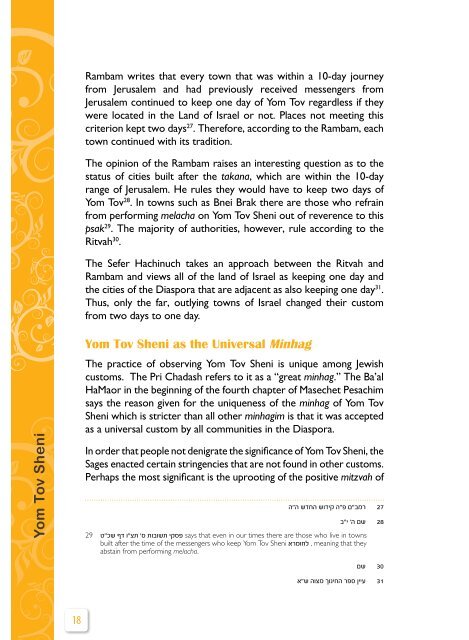Y om T o v Sheni Yom Tov Sheni - Chidushei Torah@NDS
Y om T o v Sheni Yom Tov Sheni - Chidushei Torah@NDS
Y om T o v Sheni Yom Tov Sheni - Chidushei Torah@NDS
You also want an ePaper? Increase the reach of your titles
YUMPU automatically turns print PDFs into web optimized ePapers that Google loves.
Y<strong>om</strong> <strong>Tov</strong> <strong>Sheni</strong><br />
18<br />
Rambam writes that every town that was within a 10-day journey<br />
fr<strong>om</strong> Jerusalem and had previously received messengers fr<strong>om</strong><br />
Jerusalem continued to keep one day of Y<strong>om</strong> <strong>Tov</strong> regardless if they<br />
were located in the Land of Israel or not. Places not meeting this<br />
criterion kept two days 27 . Therefore, according to the Rambam, each<br />
town continued with its tradition.<br />
The opinion of the Rambam raises an interesting question as to the<br />
status of cities built after the takana, which are within the 10-day<br />
range of Jerusalem. He rules they would have to keep two days of<br />
Y<strong>om</strong> <strong>Tov</strong> 28 . In towns such as Bnei Brak there are those who refrain<br />
fr<strong>om</strong> performing melacha on Y<strong>om</strong> <strong>Tov</strong> <strong>Sheni</strong> out of reverence to this<br />
psak 29 . The majority of authorities, however, rule according to the<br />
Ritvah 30 .<br />
The Sefer Hachinuch takes an approach between the Ritvah and<br />
Rambam and views all of the land of Israel as keeping one day and<br />
the cities of the Diaspora that are adjacent as also keeping one day 31 .<br />
Thus, only the far, outlying towns of Israel changed their cust<strong>om</strong><br />
fr<strong>om</strong> two days to one day.<br />
Y<strong>om</strong> <strong>Tov</strong> <strong>Sheni</strong> as the Universal Minhag<br />
The practice of observing Y<strong>om</strong> <strong>Tov</strong> <strong>Sheni</strong> is unique among Jewish<br />
cust<strong>om</strong>s. The Pri Chadash refers to it as a “great minhag.” The Ba’al<br />
HaMaor in the beginning of the fourth chapter of Masechet Pesachim<br />
says the reason given for the uniqueness of the minhag of Y<strong>om</strong> <strong>Tov</strong><br />
<strong>Sheni</strong> which is stricter than all other minhagim is that it was accepted<br />
as a universal cust<strong>om</strong> by all c<strong>om</strong>munities in the Diaspora.<br />
In order that people not denigrate the significance of Y<strong>om</strong> <strong>Tov</strong> <strong>Sheni</strong>, the<br />
Sages enacted certain stringencies that are not found in other cust<strong>om</strong>s.<br />
Perhaps the most significant is the uprooting of the positive mitzvah of<br />
ה”ה שדחה שודיק ה”פ ם”במר 27<br />
ב”י ’ה םש 28<br />
29 ט”כש ףד ו”צת ’ס תובושת יקספ says that even in our times there are those who live in towns<br />
built after the time of the messengers who keep Y<strong>om</strong> <strong>Tov</strong> <strong>Sheni</strong> ארמוחל , meaning that they<br />
abstain fr<strong>om</strong> performing melacha.<br />
םש 30<br />
א”ש הוצמ ךוניחה רפס ןייע 31


